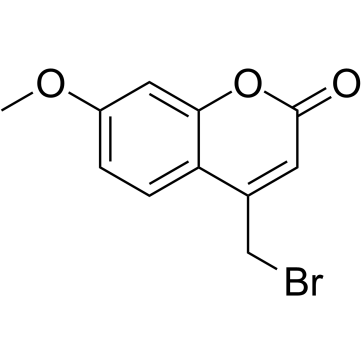4-(Bromomethyl)-7-methoxy-2H-chromen-2-one

4-(Bromomethyl)-7-methoxy-2H-chromen-2-one structure
|
Common Name | 4-(Bromomethyl)-7-methoxy-2H-chromen-2-one | ||
|---|---|---|---|---|
| CAS Number | 35231-44-8 | Molecular Weight | 269.091 | |
| Density | 1.6±0.1 g/cm3 | Boiling Point | 385.3±42.0 °C at 760 mmHg | |
| Molecular Formula | C11H9BrO3 | Melting Point | 213-215 °C(lit.) | |
| MSDS | Chinese USA | Flash Point | 186.8±27.9 °C | |
| Symbol |

GHS07 |
Signal Word | Warning | |
|
Predicting response to vascular endothelial growth factor inhibitor and chemotherapy in metastatic colorectal cancer.
BMC Cancer 14 , 887, (2014) Bevacizumab improves progression free survival (PFS) and overall survival (OS) in metastatic colorectal cancer patients however currently there are no biomarkers that predict response to this treatment. The aim of this study was to assess if differential prot... |
|
|
Characterization of adipose tissue-derived stromal vascular fraction for clinical application to cartilage regeneration.
In Vitro Cell. Dev. Biol. Anim. 51(2) , 142-50, (2015) Bone marrow concentration (BMC) is the most recognized procedure to prepare mesenchymal stem cells for cartilage regeneration. However, bone marrow aspiration is highly invasive and results in low stem cell numbers. Recently, adipose tissue-derived stromal va... |
|
|
Effect of codon adaptation on codon-level and gene-level translation efficiency in vivo.
BMC Genomics 15 , 1115, (2014) There is a significant difference between synonymous codon usage in many organisms, and it is known that codons used more frequently generally showed efficient decoding rate. At the gene level, however, there are conflicting reports on the existence of a corr... |
|
|
Exercise training, creatine supplementation, and bone health in ovariectomized rats.
Osteoporos. Int. 26(4) , 1395-404, (2015) Evidence suggests that creatine may have some beneficial effects on bone. The study aimed to investigate the effects of exercise alone or combined with creatine on bone health in ovariectomized rats. Findings show that exercise, but not creatine, has an impor... |
|
|
Novel IL1RAPL1 mutations associated with intellectual disability impair synaptogenesis.
Hum. Mol. Genet. 24(4) , 1106-18, (2015) Mutations in interleukin-1 receptor accessory protein like 1 (IL1RAPL1) gene have been associated with non-syndromic intellectual disability (ID) and autism spectrum disorder. This protein interacts with synaptic partners like PSD-95 and PTPδ, regulating the ... |
|
|
AMPD1 regulates mTORC1-p70 S6 kinase axis in the control of insulin sensitivity in skeletal muscle.
BMC. Endocr. Disord. 15 , 11, (2015) Insulin resistance triggered by excess fat is a key pathogenic factor that promotes type 2 diabetes. Understanding molecular mechanisms of insulin resistance may lead to the identification of a novel therapeutic target for type 2 diabetes. AMPD1, an isoform o... |
|
|
Prevalence of genetic variants of keratins 8 and 18 in patients with drug-induced liver injury.
BMC Med. 13 , 196, (2015) Keratin 8 and 18 (K8/K18) cytoskeletal proteins protect hepatocytes from undergoing apoptosis and their mutations predispose to adverse outcomes in acute liver failure (ALF). All known K8/K18 variants occur at relatively non-conserved residues and do not caus... |
|
|
Novel Clonal der(9)t(5;9)(q31;q34) Cytogenetic Translocation in a Giant Cell Tumor of Bone.
Appl. Immunohistochem. Mol. Morphol. 23 , e17-21, (2015) Giant cell tumor of the bone (GCTB) is a benign but locally aggressive neoplasm of long bones with higher chances of local recurrence. Many cytogenetic studies have reported clonal telomeric associations with GCTB. Here, we report for the first time a novel c... |
|
|
Inhibition of STAT3-interacting protein 1 (STATIP1) promotes STAT3 transcriptional up-regulation and imatinib mesylate resistance in the chronic myeloid leukemia.
BMC Cancer 14 , 866, (2014) Signal transducer and activator of transcription 3 (STAT3) is an important transcriptional factor frequently associated with the proliferation and survival of a large number of distinct cancer types. However, the signaling pathways and mechanisms that regulat... |
|
|
Alpha-Lipoic Acid Promotes Osteoblastic Formation in H2O2 -Treated MC3T3-E1 Cells and Prevents Bone Loss in Ovariectomized Rats.
J. Cell Physiol. 230 , 2184-201, (2015) Alpha-lipoic acid (ALA), a naturally occurring compound and dietary supplement, has been established as a potent antioxidant that is a strong scavenger of free radicals. Recently, accumulating evidences has indicated the relationship between oxidative stress ... |